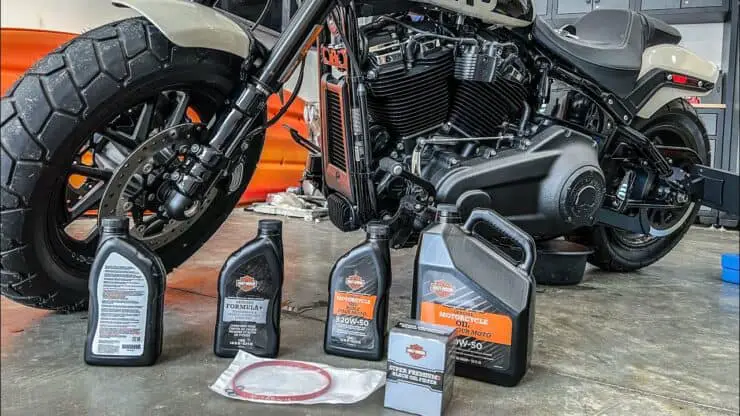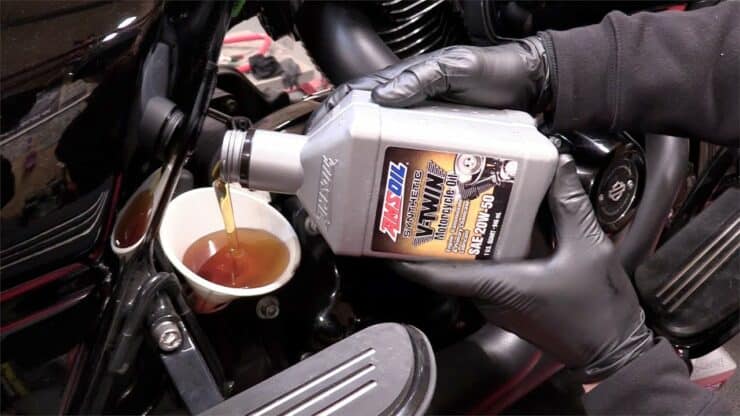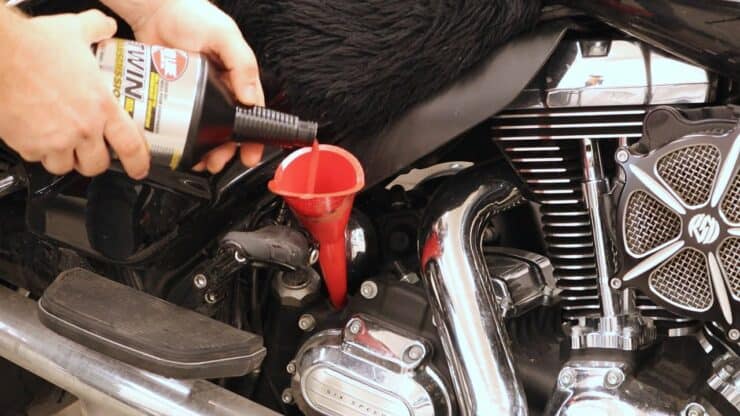If you’re a Harley Dyna owner, you want to learn how to maintain your bike. Changing the transmission fluid is an important part of doing that, and it’s not as hard as you might think! In this article, we’ll provide a quick and easy guide to changing your transmission fluid so you can keep your Harley Dyna running smoothly. So read on to learn more – your Dyna will thank you!
To change transmission fluid on a Harley Dyna, warm up the engine, locate the transmission drain plug, drain the old fluid, replace the plug, and refill with Harley-specific transmission oil.
What does transmission oil do in a Harley-Davidson Dyna?
Harley-Davidson Dyna is one of the most popular bikes in the lineup of the iconic American motorcycle brand. It offers tremendous power, exquisite performance, and a smooth riding experience. One of the critical components that contribute greatly to the efficient operation of the transmission system is the transmission fluid.
Transmission fluid in a Harley-Davidson Dyna is a specialized lubricant specifically formulated for the transmission system. It is designed for meeting the unique requirements of the Dyna models, ensuring smooth gear shifts, efficient power transfer, and protection against wear and tear. The transmission fluid in a Dyna serves a number of purposes, including lubrication, cooling, and contaminant removal.
The primary purpose of the transmission fluid is to offer lubrication to the intricate components of the transmission system. It forms a protective film that reduces friction between the moving parts, allowing for seamless gear shifts and minimizing wear on gears, bearings, and synchronizers.
As the Harley-Davidson Dyna’s transmission operates, it generates heat because of friction and mechanical processes. Transmission fluid acts as a coolant by absorbing and dissipating this heat, preventing excessive temperature rise and ensuring the transmission operates within the optimal temperature range.
Over time, debris, metal particles, and contaminants can accumulate in the transmission system. The transmission fluid consists of detergents and additives that help in removing the impurities, preventing them from causing any damage or interfering with the smooth operations of the gears and other components.
Benefits of changing transmission fluid in Harley-Davidson Dyna
Harley-Davidson Dyna bikes are known for their power, performance, and thrilling riding experience. For maintaining the optimal functioning of the transmission system, it is important to prioritize regular maintenance, including changing the transmission fluid. Here are some of the benefits that come with changing the transmission oil in your Dyna, ensuring a smoother ride and prolonging the lifespan of your beloved bike.
#1. Enhanced transmission performance
Changing the transmission fluid at recommended intervals plays a key role in optimizing the performance of your Harley-Davidson Dyna. Over time, transmission fluid can break down, accumulate contaminants, and lose its lubricating properties. This can result in sluggish gear shifts, increased friction, and reduced power transfer.
By changing the transmission fluid regularly, you’ll be able to ensure a fresh supply of clean fluid that provides optimal lubrication, allowing gears to engage smoothly and reducing wear and tear on the transmission components. Consequently, you will experience improved gear-shifting precision, seamless acceleration, and an overall enhanced riding experience.
#2. Extended transmission lifespan
The transmission system in your Dyna is a complex and crucial component. By changing the transmission fluid as recommended by the manufacturer, you’ll be able to significantly extend the lifespan of your transmission.
Clean transmission fluid helps in minimizing wear on gears, bearings, and other vital parts by reducing friction and providing effective lubrication. It’ll also prevent the buildup of contaminants, such as dirt, sludge, and metal shavings, which can result in damage and compromise the performance of the transmission. Regular fluid changes can contribute to a healthier transmission, reducing the likelihood of costly repairs or premature replacements.

#3. Prevention of overheating
Harley-Davidson Dyna motorcycles are known for their high-performance engines, which generate significant heat during operation. Transmission fluid does not just lubricate the transmission but also serves as a coolant. It helps in dissipating heat generated by friction and mechanical processes within the transmission system.
Over time, transmission fluid can lose its cooling properties, resulting in overheating and potential damage to the transmission components. By changing the transmission fluid, you’ll be able to ensure that the cooling properties are optimal, allowing the fluid to effectively regulate temperature and prevent overheating. This promotes consistent performance and protects the transmission from potential heat-related issues.
#4. Early detection of transmission issues
Changing the transmission fluid helps provide an opportunity for professional technicians to inspect the old fluid for any signs of abnormal wear or contamination. Metal shavings, debris, or discoloration could indicate potential issues within the transmission system.
By detecting the issues early on through transmission fluid analysis, you’ll be able to address them promptly, preventing further damage and minimizing the risk of sudden transmission failure. Timely intervention and necessary maintenance based on the findings can help in avoiding costly repairs and keep your Dyna running smoothly.
Necessary tools for changing transmission fluid in Harley-Davidson Dyna
Changing the transmission fluid in your Harley-Davidson Dyna is an important maintenance task for ensuring optimal performance and longevity of your bike’s transmission system. While it is recommended that you should have a professional technician perform the procedure, some bikers prefer to handle it themselves. If you’re looking to change the transmission fluid on your Dyna, it’ll be important to have the right tools and materials at your disposal. Here are the essential tools needed for a successful transmission fluid change in your Harley-Davidson Dyna.
#1. Drain pan
A drain pan is an important tool for collecting the old transmission fluid as it is drained from your Dyna. It needs to be big enough to accommodate the capacity of your transmission system, preventing any spills or leaks. You should look for a pan that has a built-in spout or a secure lid to make the disposal of the used fluid safe and easy.
#2. Socket set
A comprehensive socket set is important for removing the drain plug and any other bolts securing the transmission pan. The socket set needs to include both metric and standard sizes to ensure compatibility with various fasteners on your Dyna.
#3. Torque wrench
A torque wrench is important for tightening the drain plug and other fasteners to the manufacturer’s specified torque values. This will ensure proper sealing and prevent damage to the transmission components. You must refer to the owner’s manual for the recommended torque specifications.
#4. A funnel
A funnel having a flexible neck will allow for the easy and precise pouring of new transmission fluid into the transmission system. Look out for a funnel with a wide opening to prevent spills and facilitate a smooth flow of fluid.
#5. Rags and shop towels
Having a supply of rags and shop towels on hand will be important for cleaning any spills, wiping off surfaces, and maintaining a clean working area. Transmission fluid can be slippery, so absorbent materials will help you maintain a safe and tidy workspace.
Preparation for changing transmission fluid in a Dyna
Changing the transmission fluid in your Harley-Davidson Dyna will be an important maintenance task for ensuring smooth gear shifts and the longevity of your bike’s transmission system. Proper preparation will be key to performing the procedure efficiently and effectively. Here are some of the preparatory steps you must carry out for a successful transmission fluid change in your Harley-Davidson Dyna.
#1. Arrange safety gear
When you are working with transmission fluid, it’ll be important to prioritize your safety. You must wear gloves to protect your hands from chemicals and possible contact with sharp edges. Moreover, safety glasses or goggles are recommended for shielding your eyes from any potential splashes or spills.
#2. Read the owner’s manual
You must take the time to review the owner’s manual specific to your Harley-Davidson Dyna model. You need to familiarize yourself with the recommended transmission fluid type, capacity, and specific instructions provided by the manufacturer. This will ensure that you’re using the correct fluid and follow the proper procedures for your bike.
#3. Park your motorcycle on a level surface and prepare the workspace
You must identify a proper location to park your Harley-Davidson Dyna. Make sure that your bike has been parked on a level surface. The area must be clean and keep others away from the place you’re parking your bike.
Choose a well-ventilated area with sufficient space to maneuver around your bike. Make sure that the surface is level and stable to prevent any accidents or spills. Lay down a protective covering or absorbent material to catch any potential drips or spills during the fluid change process.

How to change transmission fluid on Harley Dyna
Regularly changing the transmission fluid in your Harely-Davidson Dyna is an important process for maintaining optimal performance and extending the lifespan of your bike’s transmission system. Here are the step-by-step process depicting how to change transmission fluid on Harley Dyna and help you ensure the transmission operates smoothly and efficiently.
Step 1: Locate the drain plug and fluid filter
Identify the location of the transmission drain plug and fluid filter on your Harley-Davidson Dyna. The drain plug will typically be located at the bottom of the transmission pan while the fluid filter is located on the side or bottom of the transmission case. You must refer to the owner’s manual or a service manual for the exact location if necessary.
Step 2: Drain the existing fluid
Position the drain pan beneath the drain plug for catching the old transmission fluid. Using the appropriate socket, you must carefully loosen and remove the drain plug. You should allow the fluid to drain completely into the drain pan. Take caution as the fluid might be hot. Once the fluid has stopped draining, securely tighten the drain plug.
Step 3: Replace the fluid filter
Locate the fluid filter and remove it using the appropriate tools. Inspect the filter for any signs of damage, contamination, or excessive wear. Replace the old filter with a new one of the same specifications. Make sure there is proper alignment and secure the new filter in place.
Step 4: Refill with fresh fluid
Using a funnel, you should pour the recommended amount of new transmission fluid into the fill port. Refer to your bike’s owner’s manual for the correct fluid capacity and specifications. Take care that you do not overfill the transmission. Monitor the fluid level using the appropriate method (such as dipstick or sight glass) and adjust as needed.
Step 5: Check for leaks and proper fluid level
Once the transmission has been refilled, start your bike and allow it to idle for a few minutes. Check if there are any signs of fluid leakage around the drain plug, filter, or fill port. If any leaks are detected, you must promptly address and resolve them. Moreover, you should verify that the fluid level is within the recommended range.
Step 6: Clean up and dispose of old fluid properly
Clean up any spilled fluid using shop towels or rags, ensuring that the workplace is clean and free of any residual fluid. Dispose of the old transmission fluid responsibly according to local regulations. Many automotive stores and service centers accept used fluids for proper disposal.
Common transmission fluid issues and how to troubleshoot them
After changing the transmission fluid in your Dyna, there might be times you might get issues here and there. You might encounter issues during or after the fluid change process. Here are some of the common problems that bikers might face when changing transmission fluid in their Harley-Davidson Dyna. You will also get to know how to troubleshoot those issues.
Clutch won’t engage
After changing the transmission fluid, you might find that the clutch won’t engage, preventing you from shifting gears or causing difficulty in engaging the clutch lever. Here are some of the troubleshooting tips to resolve the clutch won’t engage issue.
Make sure that the transmission fluid is at the correct level. Low fluid levels can result in insufficient hydraulic pressure, resulting in clutch engagement issues. If necessary, you need to top up the fluid to the recommended level. Air trapped in the clutch system can help prevent proper engagement. Bleed the clutch system following the manufacturer’s instructions to remove any air bubbles and restore optimal performance.
Check the clutch cable for any signs of damage, fraying, or improper adjustment. A faulty or improperly adjusted clutch cable can hinder clutch engagement. Remember to adjust or replace the cable as needed.
Motorcycle won’t move
After you have changed the transmission fluid, you might experience the motorcycle not moving despite engaging the clutch and shifting gears. If you want to fix this issue, you will need to follow a set of steps.
Make sure that the clutch is properly adjusted. An improperly adjusted clutch can result in insufficient power transfer to the transmission. Adjusted the clutch cable or hydraulic system according to the manufacturer’s specifications.
Double-check that you’re in the correct gear. Make sure that you’re fully engaging the gear and not stuck in a neutral position. Worn or damaged clutch plates can cause slippage and prevent power transfer to the transmission. Inspect the clutch plates for signs of wear or damage and replace them if needed.
Difficult gear shifting
After you have changed the transmission fluid, you might find it difficult to shift gears smoothly and experience resistance or grinding noises. To make sure that you’re able to fix this issue, make sure that you have used the correct type of transmission fluid recommended by the manufacturer. Incorrect fluid type of low fluid level can result in gear shifting issues. Drain and refill the transmission with the proper fluid if needed.
Examine the clutch cable for proper adjustment and smooth operation. A misadjusted or damaged clutch cable could hinder gear shifting. Adjust or replace the cables as necessary. Check the shift linkage for any signs of wear, damage, or misalignment. Worn-out or misaligned linkage can impede smooth gear shifting. Adjust, lubricate, or replace the linkage components as needed.
Worn-out or damaged clutch cables can result in difficulties in gear shifting. You must inspect the clutch cables for wear, warping, or contamination. Replace them if needed.

Signs that it is time to change the transmission fluid
The transmission fluid in your Harley-Davidson Dyna plays a key role in ensuring smooth gear shifts, optimal performance, and the longevity of your bike’s transmission system. Over time, the fluid can become contaminated or degrade, resulting in diminished performance and potential damage to the transmission components. Here are some of the warning signs that indicate it is time to change the transmission fluid in your Harley-Davidson Dyna.
#1. Slipping gears
One of the primary signs that it is time to change the transmission fluid will be when you start experiencing slipping gears. If you’re noticing that the gears aren’t engaging properly, shifting unexpectedly, or disengaging under normal riding conditions, it might indicate a lack of sufficient fluid pressure or worn-out transmission fluid. Changing the transmission fluid can help restore the necessary hydraulic pressure and improve gear engagement.
#2. Rough or delayed shifting
If you are experiencing rough or delayed shifting, it can be a result of degraded transmission fluid. As the fluid breaks down, it will lose its ability to provide smooth lubrication and facilitate seamless gear changes. You might notice grinding or clunking noises during shifting or a delay in the response when shifting gears. Changing the transmission fluid will help resolve these issues and promote smoother gear transmissions.
#3. Transmission overheating
Overheating of the transmission is another warning sign that your Harley-Davidson Dyna’s transmission fluid might require changing. If you notice the transmission temperature gauge running hotter than usual or receive warning indicators, it can be due to the degraded fluid being unable to properly cool and lubricate the transmission components. Fresh fluid with its optimal viscosity and heat dissipation properly can help regulate the transmission temperature and prevent overheating.
#4. Fluid discoloration or foul odor
Inspecting the transmission fluid will be an important step in determining its condition. Healthy transmission fluid is typically reddish or pinkish in color and has a clean, slightly sweet odor. If you notice a dark or brownish color or a burnt smell resembling that of charred paper, it’ll indicate contamination or excessive wear of the fluid. Changing the fluid will remove the contaminants and help restore its lubricating properties.
#5. High mileage or scheduled maintenance
If your Harley-Davidson Dyna has accumulated high mileage or if it has been a considerable amount of time since the last transmission fluid change, it is typically recommended to have the fluid replaced. High mileage and prolonged use can cause the fluid to deteriorate, resulting in decreased performance and potential damage to the transmission. You should check the manufacturer’s recommendations or consult the owner’s manual for the suggested maintenance intervals.
FAQs
What type of transmission fluid should I use for my Harley Dyna?
The type of transmission fluid you should use for your Harley Dyna depends on the year and model of your bike. Generally, Harley recommends using synthetic SAE 75W-140 transmission fluid for all 2006 and newer Harley Dyna models. For older models, you should consult your owner’s manual for the recommended type of fluid.
How often should I change my Harley Dyna transmission fluid?
It is recommended to change the transmission fluid in your Harley Dyna every 20,000 to 25,000 miles. If you ride in dusty or wet conditions, you may need to change it more frequently.
What is the process for changing the transmission fluid on a Harley Dyna?
The process for changing the transmission fluid on a Harley Dyna includes draining the old fluid, cleaning the transmission case, installing a new filter, and refilling the case with the new transmission fluid. Before attempting this process, you should consult your owner’s manual for specific instructions and requirements for your bike. It is also important to use the specified type of transmission fluid and to make sure the fluid level is correct before operating the bike.

